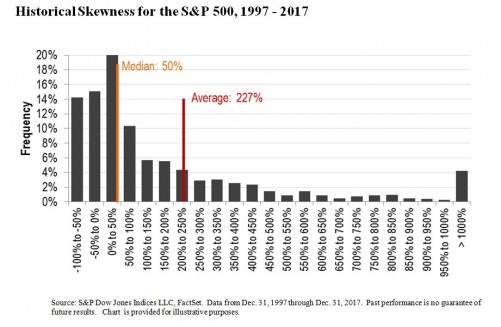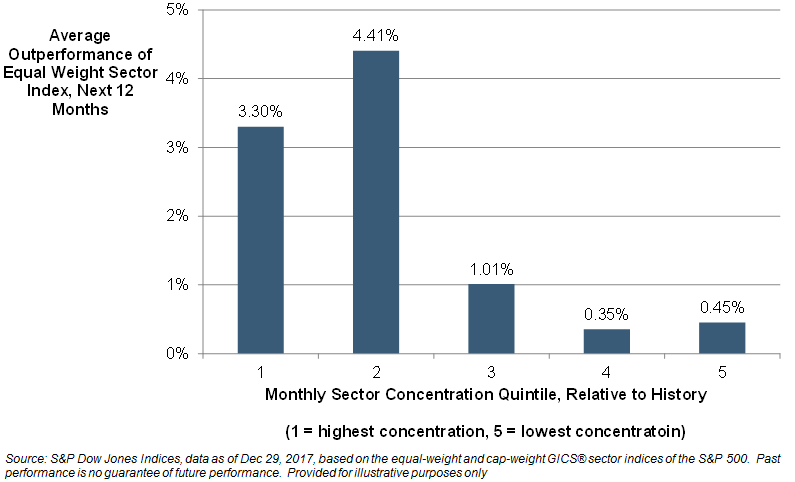In my previous blog, we compared a daily inverse index to a “true short” and discussed the increasing vega exposure in the S&P 500® VIX® Short Term Futures Inverse Daily Index over the past couple of years. In this blog, we analyze how the mechanics of a VIX futures index, a low volatility environment, and various forces in the market may have contributed to the after-hour spike of VIX futures contracts on Feb. 5, 2018.
Rolling of VIX Futures Is a Double Edged Sword in VIX Futures Index Performance
The benchmark VIX futures index, the S&P 500 VIX Short-Term Futures Index, replicates a rolling futures position on the CBOE Volatility Index (VIX) using the two nearest futures contracts on VIX. That means that its inverse, the S&P 500 VIX Short Term Futures Inverse Daily Index, theoretically is buying the front-month futures and selling the second month’s futures on a daily basis. In a contango market, which occurs about 80% of the time in the history of the index (shown in Exhibit 3 in this post), this buying/selling can translate into positive carries in the long term. However, a huge jump in volatility and an inversion of the VIX futures curve could result in a double blow on the S&P 500 VIX Short Term Futures Inverse Daily Index and the exchange-traded products (ETPs) that track it.
VIX ETPs, Other Institutional Investors, and the After-Hour Spike in VIX Futures
VIX ETPs rebalance after market close once they get the target weights for the next business day. Even though the size of the VIX ETP market is small relative to the overall U.S. equity market, it is sizable relative to the VIX futures market. A recent research piece published by Goldman Sachs, “VIX: Q&A on the Trading Dynamics of ETPs,” estimated that the size of the VIX ETP market accounts for roughly 40% of open interest of the VIX futures market.
When volatility rises, market participants are economically incentivized to buy VIX futures: the inverse VIX ETP issuers may do so to reduce a short position that has become too large; the leveraged VIX ETP issuers may do so to supplement a long position that has not risen as quickly as the AUM of the ETP itself. Goldman Sachs research group estimated that the after-hour “vega to buy” on Feb. 5, 2018, exceeded 200,000 VIX futures.
It is worthwhile to note that institutional investors that have also employed short volatility strategies would likely need to buy VIX futures to cover their short positions. The same applies to the systematic strategies that may have had hedging triggered. The end result of these combined forces is an accelerated price spike in VIX futures contracts in extended trading hours (see Exhibit 1).

Low VIX Levels Increased the Probability of a 100% Jump
Finally, VIX had been hovering in the lower teens for quite a long time. The lower level of VIX futures also made an n-point move a higher percentage than it would be with higher VIX futures prices. For example, a 10-point jump would be a 100% return with the VIX level at 10, and a 50% return with the VIX level at 20.
In conclusion, several variables appear to have contributed to the recent events witnessed in the VIX space. The combination of capital flowing into inverse ETPs, the compounding power of daily inverse indices and their index-linked ETPs, systematic trading strategies, a low VIX environment, a jump in volatility, and an inversion of the VIX futures curve together led to an accelerated rally in VIX as demonstrated by the ultimate drawdown in the inverse version of the asset class. The key takeaway for market participants from this event is that volatility is a complex asset class and one that has various players interacting at different levels based on their own economic interests. Therefore, understanding the mechanics of VIX futures and VIX futures indices should be a starting point for any volatility market participant.
The posts on this blog are opinions, not advice. Please read our Disclaimers.









